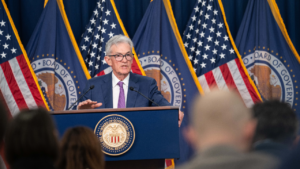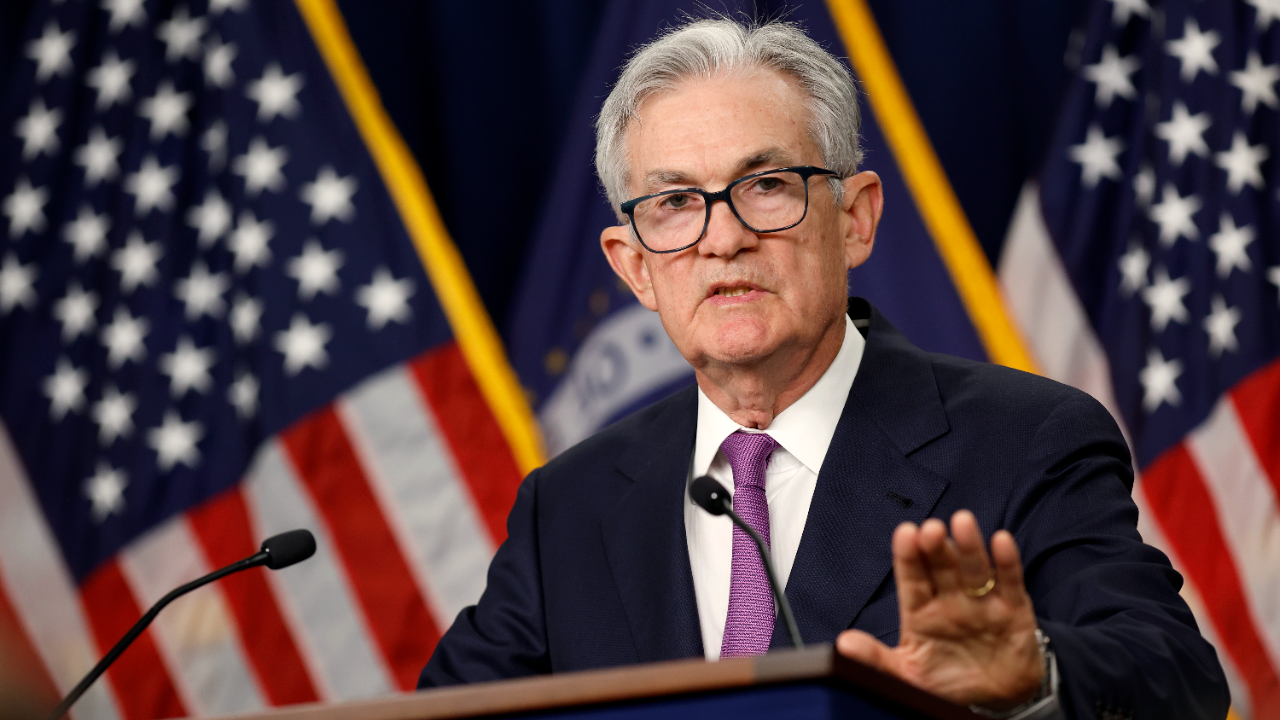Here’s why low inflation has the Fed concerned right now

When the Federal Reserve announced its interest rate decision last week, it let you in on a vexing, unsolved mystery that’s been perplexing U.S. central bankers for the latter half of 10 years: With the best job market in decades, why isn’t there more inflation?
For years, economic theory has suggested that the Fed’s two objectives – stable prices and maximum employment – have an inverse relationship. When one (unemployment) goes down, the hypothesis suggests that the other (inflation) should go up.
Throughout most of the current expansion, however, that hasn’t really been the case. Even with the labor market tight and the unemployment rate at a 49-year low, inflation hasn’t quite reached the level where Fed officials want it to be – 2 percent – at a point that’s been sustainable.
It’s becoming quite a concern for officials at the U.S. central bank. Fed Chairman Jerome Powell said during the April-May meeting’s press conference that if inflation continues to consistently register below that target, the Federal Open Market Committee (FOMC) would take it into account when setting policy. The occurrence has been so puzzling that officials look like they’ll be putting it at the center of their policy framework review set for June.
But just because this is one of the more esoteric aspects of Fed policy, doesn’t mean you should turn a blind eye. Believe it or not, your expectations of where inflation will be in the future can influence how your purchasing power plays out. Inflation also has major implications for your pocketbook and the broader economy.
Here’s everything you need to know about inflation, and why it’s such a conundrum for U.S. central bankers right now.
The basics of inflation
In one way or another, we’re all impacted by inflation.
Whether it’s at the gas station or the grocery store, when prices increase, you feel it. It seems like the dollars in your wallet don’t go as far – or can’t purchase as much – as they used to.
Generally, this is what inflation measures: price changes in goods and services. It tracks how your purchasing power changes over time.
Even though it might seem like a bad thing if your dollars don’t go as far, a moderate level of inflation is good, according to the Fed. It makes it less likely that the economy will fall into deflation, something that many economists say is far worse because it keeps people from wanting to spend.
A higher inflation rate, on the other hand, suggests that the economy could be overheating. It may also reduce your purchasing ability.
As a result, the Fed has a “goldilocks” inflation rate – that is, when price stability isn’t too hot or too cold. On an annual basis, the Fed hopes that prices will rise by 2 percent, an objective it officially set in 2012.
How does the Fed know it’s hitting that target? By reviewing two main indexes that measure inflation: consumer price index (CPI) and personal consumption expenditures (PCE). Both indices measure the prices of a typical “basket of goods” and study how they change over time.
CPI looks at what households are buying, while PCE analyzes what businesses are selling, according to the Cleveland Fed. Fed officials look at both measures, but they prefer PCE, which tends to run lower than CPI.
Where inflation is at right now
But these measures are published with a lag and are backward-looking by nature, says Robert Brusca, chief economist at Fact and Opinion Economics, who used to work for the Federal Reserve Bank of New York.
“They tell you what inflation was, not what inflation is,” according to Brusca. “You wouldn’t want to drive your car looking out of the rearview mirror.”
The Fed has historically modeled future inflation for policy using an economic model known as “the Phillips curve.” This theory suggests that the relationship between the unemployment rate and wage growth typically predicts inflation, says Joe Brusuelas, chief economist at RSM.
Think of it as a chain of events: Economic growth leads to more jobs. More jobs push down the unemployment rate. A low unemployment rate suggests that the labor market is tight. And employers, as a result, hike wages to recruit more workers, and in turn, pass those along to consumers in the form of higher prices.
Today, however, that theory is in dispute. Wage growth and inflation have been modest during this economic expansion, even with growth registering above 3 percent in the first quarter of 2019 and an unemployment rate at 3.6 percent.
Excluding the volatile food and energy categories, inflation in March cooled to 1.6 percent on an annualized basis, the slowest pace since January 2018, according to the most recent PCE reading from the Department of Commerce. Meanwhile, wages grew on a year-over-year basis to 3.2 percent from 3.4 percent in the prior month, which was the fastest pace of the expansion, the Department of Labor’s most recent jobs report shows.
As a result, the Phillips curve has been flat.
“It’s a concern that we’ve had such a strong rate of growth when you compare it to potential, and yet we’re still not seeing inflation move up to the levels that the Fed would want,” says Sarah House, director and senior economist at Wells Fargo Securities.
Technology and automation might have something to do with the flatness of the curve, Brusuelas says. These developments have depressed wage growth.
“You have quite a bit of automation in the pipeline, followed by the integration of advanced technology,” Brusuelas says. “Technology acts as a natural deflationary impulse, even amidst an economy that’s growing at a solid rate, even with an unemployment rate below 4 percent.”
San Francisco Fed President Mary Daly suggested in a March 26 speech that the increased number of businesses that open locations abroad could also be to blame.
“Declining unionization, along with increased automation and globalization, have made it harder for workers to push for higher pay, even in very healthy job markets,” Daly told the Commonwealth Club of San Francisco. “This weakens the link between employment and wage growth.”
Why the Fed is concerned about inflation staying below its target
The Fed cares about missing its target for two main reasons. First, if inflation consistently falls below the Fed’s 2 percent objective when times are good, it makes it even harder for the Fed to respond to a downturn.
“No urgency to raise rates means rates remain at a lower level,” says Mark Hamrick, Bankrate’s senior economic analyst. Consequently, the Fed has “less ammo to draw from when the inevitable downturn is evident.”
It’s also a credibility issue for the Fed, Brusca says. It’s important for the public to have faith in the central bank’s ability to steer the economy, he says.
“Think of it in terms of fidelity,” Brusca says. “If you don’t trust your husband, and he’s done bad things in the past, and you hear something, you’ll blow up in a rage. Maybe it will spoil your relationship. It’s the same thing with inflation and the Fed.”
What can help bring inflation up?
In his semi-annual testimony to Congress, Powell brought up a tricky economic concept. The chief central banker told the Senate Banking Committee that the public’s expectations of inflation are “the most important driver of actual inflation.”
It works like this: If a large amount of people expect inflation to rise in the future, they might make their purchases now, while their money still travels far. Workers will then ask their employers for a pay raise, and businesses will consequently pass along those increases by rising prices. Those events, economists say, create the inflation that was anticipated all along.
Inflation expectations “can lead to consumer decisions and actions,” Hamrick says. “Once this cycle begins to gain traction, it’s easy to see how it can gain speed and damage the economy. This is one reason that economists and the Fed keep an eye on so-called inflation expectations.”
But if the public trusts the Fed and firmly believes that it has a handle on inflation, they won’t react too heavily to any deviations as they come in, Brusca says. For example, if inflation comes in above 2 percent next month, you won’t panic because you have faith that the Fed knows what it’s doing.
“If the Fed doesn’t get inflation expectations well-anchored, then these types of deviations can cause people to change their habits,” Brusca says. “This will cause inflation to become more unsustainable.”
A number of indices seek to measure where both the financial markets and general households see inflation heading, Brusuelas says. One of the Fed’s favorite gauges is the “five-year, five-year forward” inflation expectation and its “breakeven inflation rate,” out of the St. Louis Fed. These indices measures where inflation is expected to go over the five-year period beginning five years from today.
The first one worth looking at is the “breakeven” rate, Brusuelas says, which shows that inflation expectations are currently around 1.86 percent, according to the St. Louis Fed. That means inflation is still expected to be below the Fed’s target five years from now.
“That’s a good thing,” Brusuelas says. “That shows the Fed has a handle on inflation expectations, and it gives them latitude to implement a policy that airs on the dovish side, meaning rates can be lower for longer.”
Households, on the other hand, are surveyed by the University of Michigan in its consumer sentiment index. That gauge shows that households are expecting an inflation rate of about 2.5 percent over the next five years, according to its April reading.
How low inflation could harm the economy
If these inflation expectations aren’t stable, it could have massive implications for the health of the economy, Brusuelas says.
“Over time, if inflation moves away from 2 percent, whether it’s to the upside or toward zero, it will begin to harm the economy in ways that we don’t quite understand very well,” Brusuelas says. “Without expectations being well-anchored, the path of the rate of interest means little.”
Interest rates, after all, are the Fed’s main way of stimulating the economy, Hamrick says.
“Among the most urgent periods in the life of a central banker is when the economy is faltering, in a recession or crisis,” Hamrick says. “If the major lever — interest rates — isn’t at their disposal during such challenging times, that’s an even bigger problem.”
During the May press conference, Powell brought up the relationship between inflation and expectations — a slippery slope for the economy if both continue to cool.
“It’s important that inflation run symmetrically around 2 percent,” Powell said. If “most of the misses are on the downside, inflation expectations over time could be pulled down and that could put downward pressure on inflation,” making it “harder for us to react to downturns and support the economy in difficult times.”
The Fed could potentially adopt a new inflation framework when it meets for a review in June. That could be an “average inflation target,” which aims to keep inflation higher during good times, to make up for being lower during downturns. Vice Chair Richard Clarida said in an April 9 speech that he would be open to considering the idea.
But before that happens, keeping an eye on inflation expectations in general is a good move, according to Brusuelas. It could potentially foreshadow the Fed’s next move.
“Should you begin to see a deterioration in those forward-looking expectations,” he says, “that would imply the Fed could possibly begin to cut interest rates.”
Learn more:
You may also like

How inflation affects the stock market





